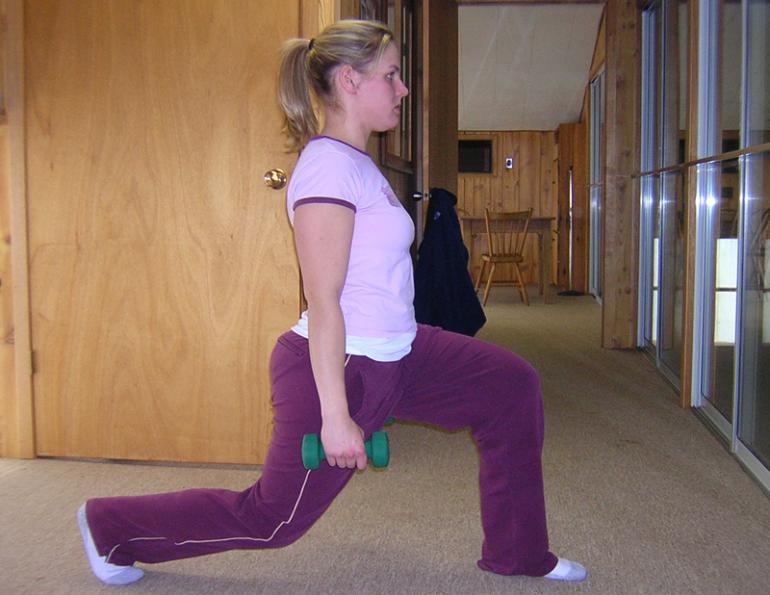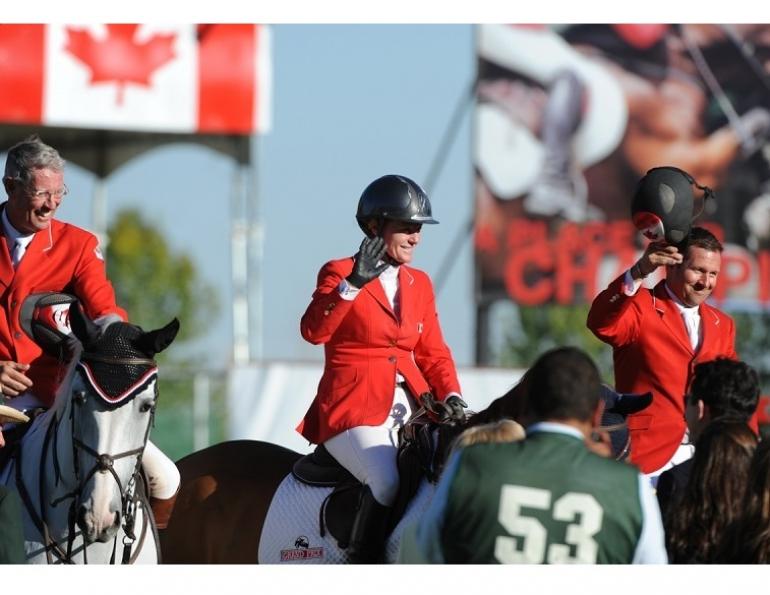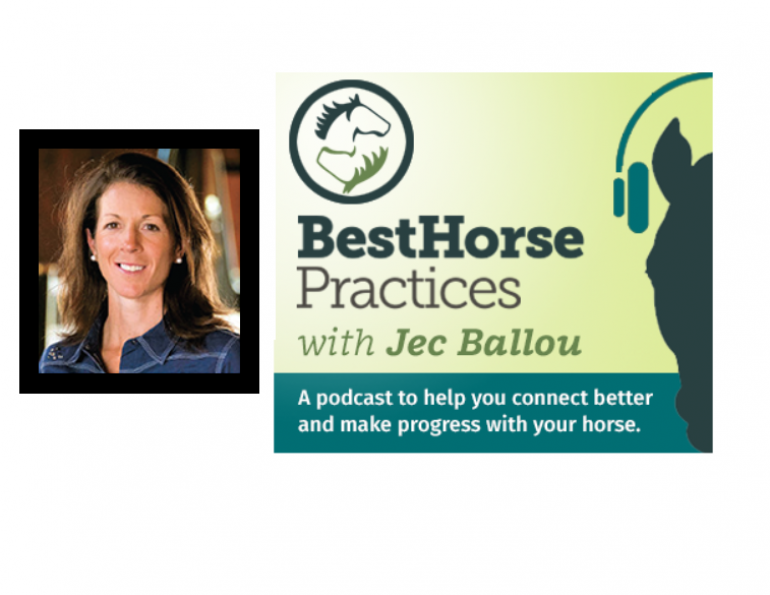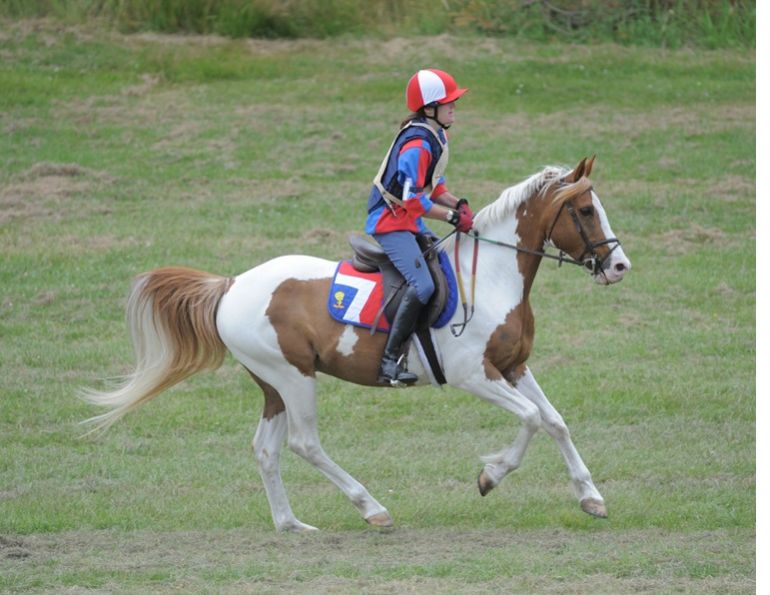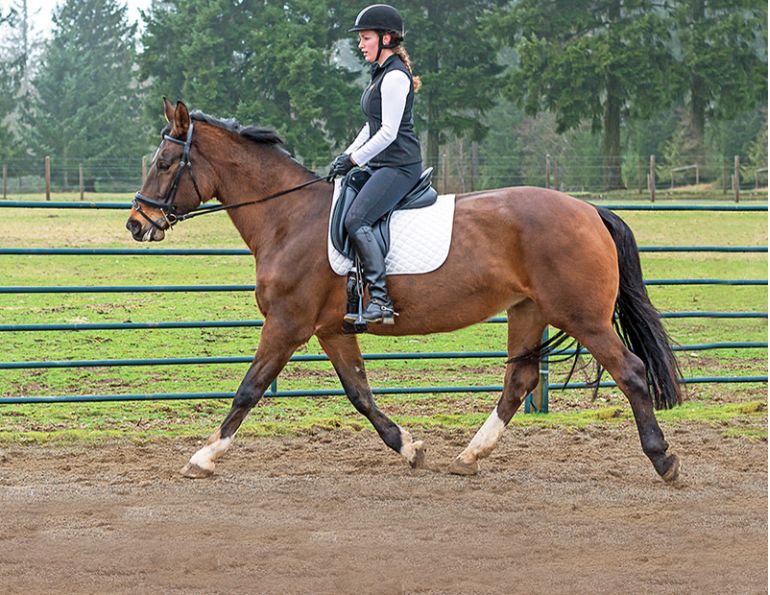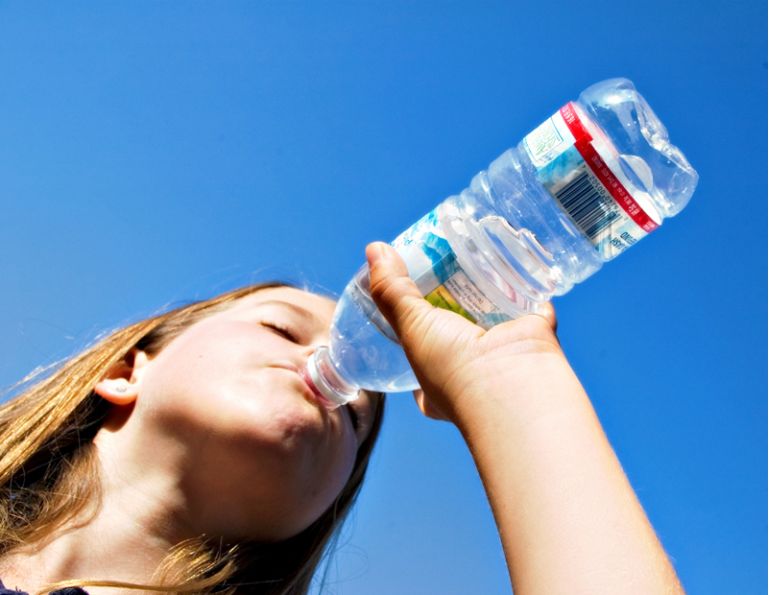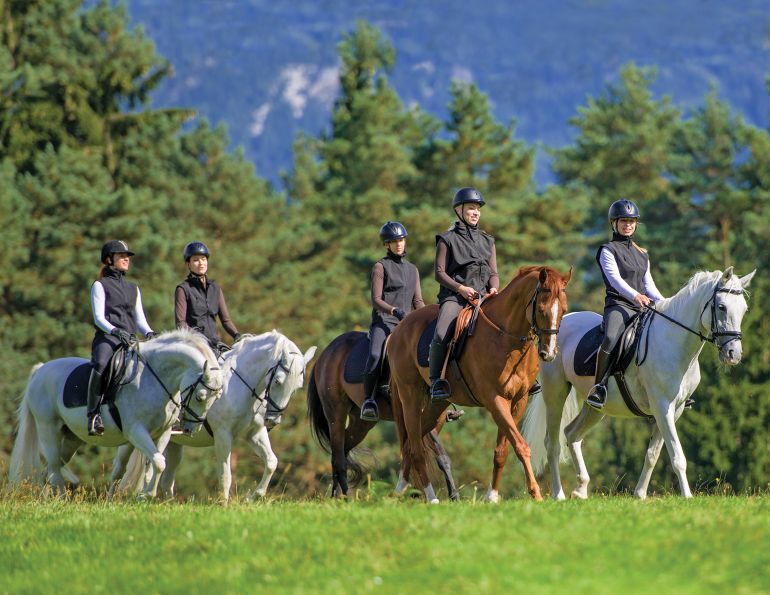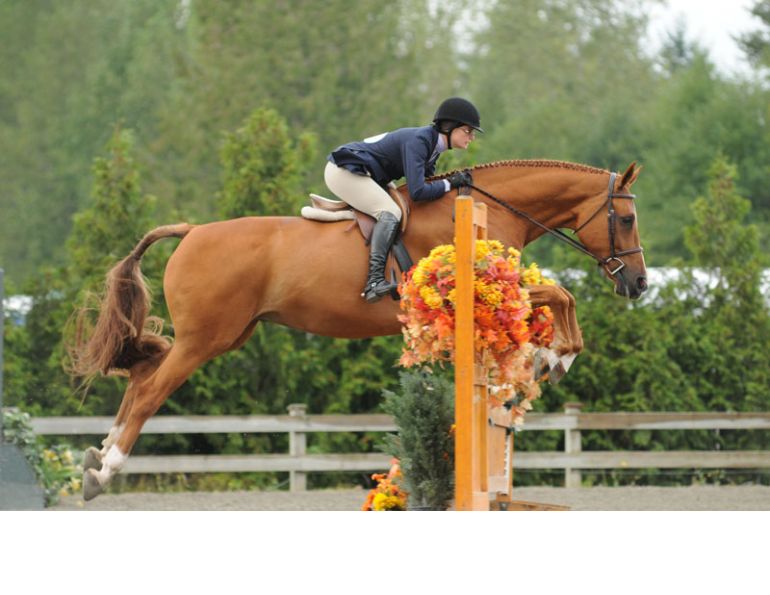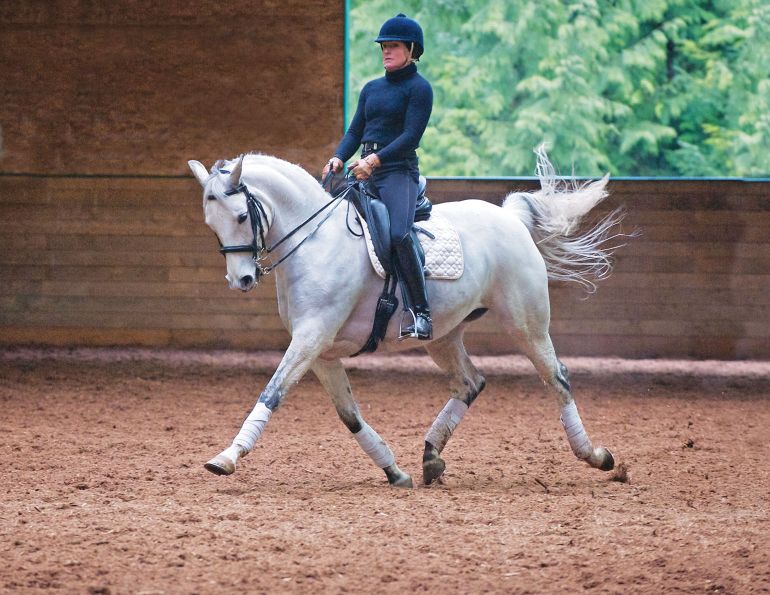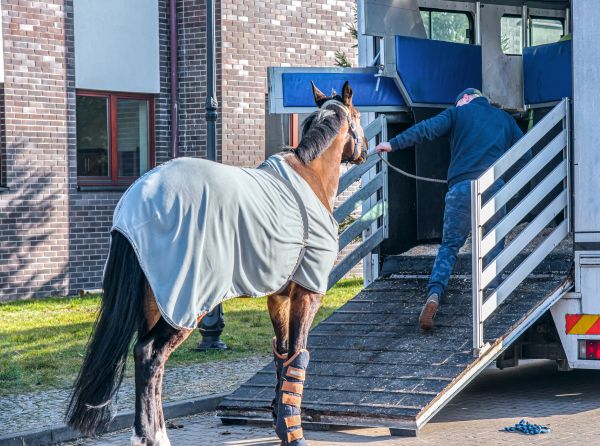By Heather Sansom
It’s that time of year again. Whether your show season is starting up again in the next couple of months, or you’re just planning on spending more time in the saddle, some off-horse training can help with stamina, effective aids, posture, and reducing risk of injury when working with your horse.
If you are like many riders, you just don’t have time to squeeze going to a gym into your week. The good news is that there is a lot you can do without setting foot in a gym. If you do use a gym, some tweaks to your program will bridge the gap between general fitness and cross-training to help your riding.
If you show, you’re up early and need to be as sharp for a class or test at 4 pm as you were at 8 am. You need to have the self carriage you expect of your horse. Also, depending on your discipline, the physical load placed on your body will vary through the day.
As with any competitive sport, the purpose of cross-training with activities other than your sport is to help you build strength and stamina which exceeds your actual requirement at the competition, so you are ready for anything.
Even if you’re not showing, you still want to have energy, endurance, and an ability to respond to the demands that working with your horse places on your body, so you can avoid injury and strain. Excessive fatigue puts you at risk for injury.
Put Your Heart Into It
Cardiovascular health affects your energy levels and endurance in the saddle. Muscles require oxygen to produce energy. Low cardiovascular ability means that your blood does not pump enough oxygen to your muscles to meet demand.
You don’t have to train to run a marathon, but improving the ability of your heart and lungs will translate directly into endurance and energy. For riders, this translates directly into mental alertness and physical neuromuscular coordination needed for the precise movements or fast response.
If you are training for more demanding disciplines such as eventing, or want to lose some weight to improve your self-carriage, you need at least 30 minutes of cardiovascular work two to three times a week, combined with strength training. For a dressage rider who does not have weight loss goals, 15 to 20 minutes of work that elevates your heart rate at least two times a week will be sufficient. The key is to work at an intensity level within your target training zone.
The target training zone for most adults is roughly between 125 to 150 beats per minute, or about 20 to 24 beats per ten seconds which you can measure with your pulse if you don’t have a heart rate monitor. When you are in your zone, you will feel the need to breath through your mouth to get oxygen, but you shouldn’t feel like you are gasping. You should be able to carry on a conversation.
If you have not been very active, you may only be able to work in your target zone for a few minutes before you take a breather. You do not have to run unless you want to: any activity you enjoy will do, and walking can be made more intense by swinging your arms back and forth (swivelling your shoulders, not just pumping arms).
If you are not certain how intensely you should be working out due to health considerations, make sure you consult your doctor about a healthy training zone for you.
Strength and Core Strength for Riders
I am often asked whether being in the saddle for long hours or doing barn chores is enough for developing strength appropriate to riding. Like any repetitive activity, riding and work with your horses place specific and repetitive demand on some muscle groups and not others, and actually create strain over time.
I am also asked whether Pilates is sufficient strength training for riders. Pilates provides many great exercises for endurance and core strength, and has great value for self-carriage of the rider. However, it’s important to remember that horses are livestock, and you often have to respond suddenly to unexpected situations which require more strength.
Improving the right kind of strength and reducing risk of injury are both helped by balanced strength training for key muscle groups such as the muscles stabilizing your pelvis, core and shoulders. While running alongside your horse, roping, and other activities place high demand on your legs, quieter disciplines such as equitation or dressage also require strong and balanced leg muscles to maintain correct posture and apply aids efficiently.
Correct posture is achieved through engagement of the back, shoulders, abdominal, oblique, and hip muscles, while your legs squeeze the horse (inside of your leg) or shift back to apply aids (outside of the leg). Building good postural balance starts with building balanced leg strength, so that your pelvis is straight to start with.
It’s important to remember to do a two to three minute general warmup before performing any strength training exercises. If you tend to tense up in the saddle, you may want to do your off-horse exercise prior to your ride, so that your body is more balanced and relaxed when you get on your horse.
As you get ready for the show season, keep in mind that your training one month will produce results in the following weeks, so start training early. You will want to train lightly in the week preceding a show so that you do not over-train, and so you peak on the show day and not before.
A great exercise for building balanced leg strength and improving balance and upper body posture is the lunge. The strength training lunge is different from the runner’s stretch.
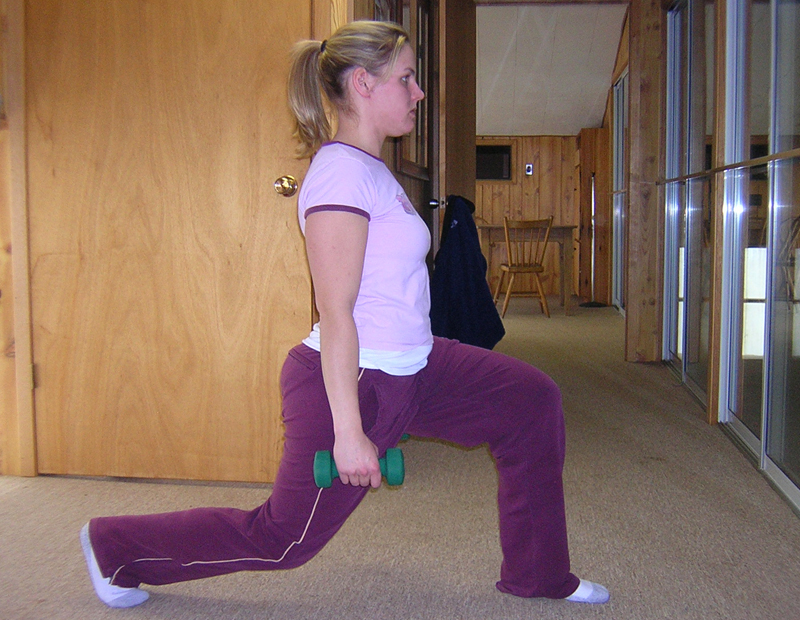
Photo #1: Lunge
Done correctly for riding, you will want to keep your shoulders straight above your pelvis, and upright.
Engage your core to prevent wobbling. Your front leg should be parallel with the floor, and your knee should be directly over your ankle, not forward past your toes. For added difficulty, hold free-weights, or cross the front leg over. To modify this exercise for problematic knees, or if you do not have the strength for a full lunge, simply take a smaller step forward and only drop your body slightly. I recommend 20-30 repetitions for each leg, at least twice a week (see photo #1).
Barn choring has a tendency to produce back strains and tight chest muscles, which can be corrected through strengthening your back, legs, shoulders, and core. It is quite common for riders and people engaged in barn choring to have tight chest muscles, and relatively weak back muscles. The effect on your posture in the saddle is to pull your top half forward, rounding your shoulders forward. Many riders experience rounded shoulders, strain in the area between the shoulder blades, or even lower back pain.
Imbalance between chest and back muscles can also cause a rider to rely on the biceps to brace in the saddle, or to pull against a pulling horse. If you try gripping something and pulling on it using your bicep, you will notice your hands tighten and become hard. Using your chest and biceps to help you control the horse results in hard hands, and ultimately a hard-mouthed horse. Having good shoulder and back strength will help you brace your back more effectively, resist engaging your biceps to pull on the horse’s mouth, and maintain soft hands.
I like to recommend work with exercise balls because they provide a destabilizing element more similar to the conditions you face on your horse, and performing exercises like simple crunches or back extensions on a ball will engage all kinds of smaller muscles in your waist, back, and hips.
To perform the back extension, lie face down over an exercise ball or other sufficiently padded object so that it is right under your pelvis. You should feel as if you would roll forward onto your face, unless your heels were held down. You can do this exercise with your feet hooked under an object, or braced against a wall behind you.
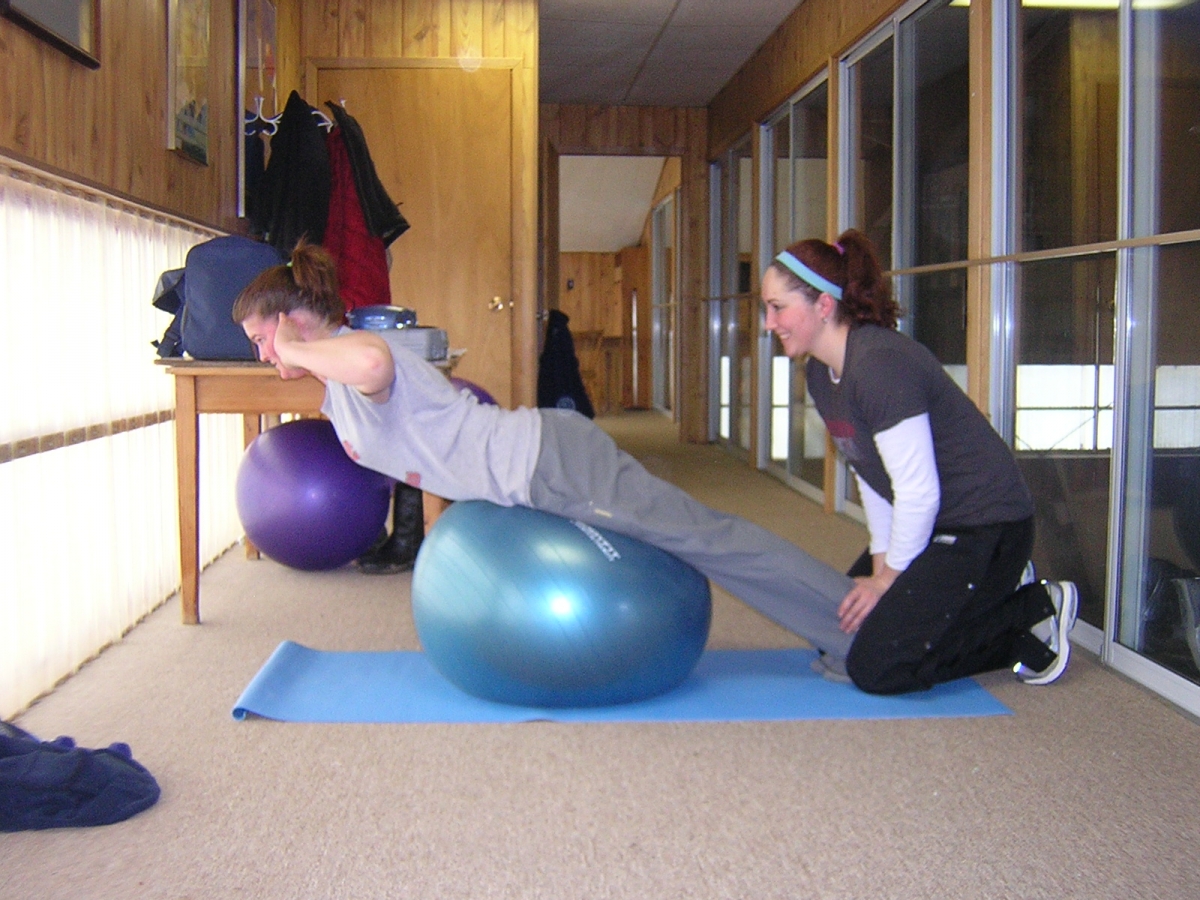
Photo #2: Back Extension
If you are working with a partner, it can be very useful to ask them to help you with your symmetry by observing whether your back, hips, and shoulders are straight and even throughout the exercise.
You will have a natural tendency to favour your stronger side, so make an effort to be aware of your body and use both sides of your back evenly. Raise your upper body into a straight, diagonal line with your legs.
Hyperextending your body or raising it higher will put unwanted pressure on your back. I recommend gradually adding repetitions until you can do 30 in a row.
You can hold weights or add a twist motion for added difficulty (see photo #2).
The exercises mentioned above are not a complete body workout.
Flexibility
Flexibility in all your major muscle groups and joints is particularly important since tight areas are usually the first to be ripped or injured, and have a negative effect on your posture and riding aids. For example, tight ankles or knees can cause you to be pushed up in the saddle, unable to absorb the movement of your horse, and therefore unable to sit deeply. Tight hip flexors will inhibit your canter aids with your seat and create tightness in your pelvis for flying changes, or simply make it difficult for you to lift your leg in over the saddle while mounting, or lengthen your legs sufficiently.
Stretching is best done dynamically before riding or working out, and statically (stretch and hold) afterwards. Doing static stretching beforehand does not warm up your muscles, rather, it pulls on cold muscles, and places muscles and joints more at risk for strain during your workout. When you stretch after a workout or at the end of the day, do not bounce, and do not push yourself to the point of pain. Go into a stretch breathing deeply until you can feel a slight pull on the muscle, then stop there and relax, breathing in and out deeply for four or five breaths until you feel the muscle relax further, then you can deepen your stretch a little more.
If you are doing a stretch and you feel pain in any joint, move out of the stretch and find a modification that does not place strain on a joint. Over time, you will improve and will see the results in fewer aches and strains, and more effective and precise aids.
I recommend daily stretching for riders, for five to ten minutes.

Photo #3: Chest & Bicep Stretch
Using stretching time as an opportunity to unwind from your day, relax tight muscles, and spend some valuable time visualizing your future performance in the ring cannot only directly benefit your riding, but also play a significant role in reducing general stress.
Some great stretches for opening up your chest and hips and lengthening those tight hip flexors are the pectoral and forearm stretch, pigeon, and downward dog.
To stretch your chest, stand with your back to a wall or stand in a doorway, raise your arm to about shoulder level, and place your palm on wall or edge of doorway, fingers pointing back and thumb up.
Lean into your shoulder, and twist your body away from that shoulder. You can do a similar stretch in a doorway with your arms bent, and the elbow at the doorframe.
The bent arm version stretches only the chest muscles, while the straight arm version will stretch both your chest, and your bicep (see photo #3).
The downward dog stretch is a yoga pose, and a great multi-muscle and joint stretch for ankles, back, hamstrings, calves, and shoulders.
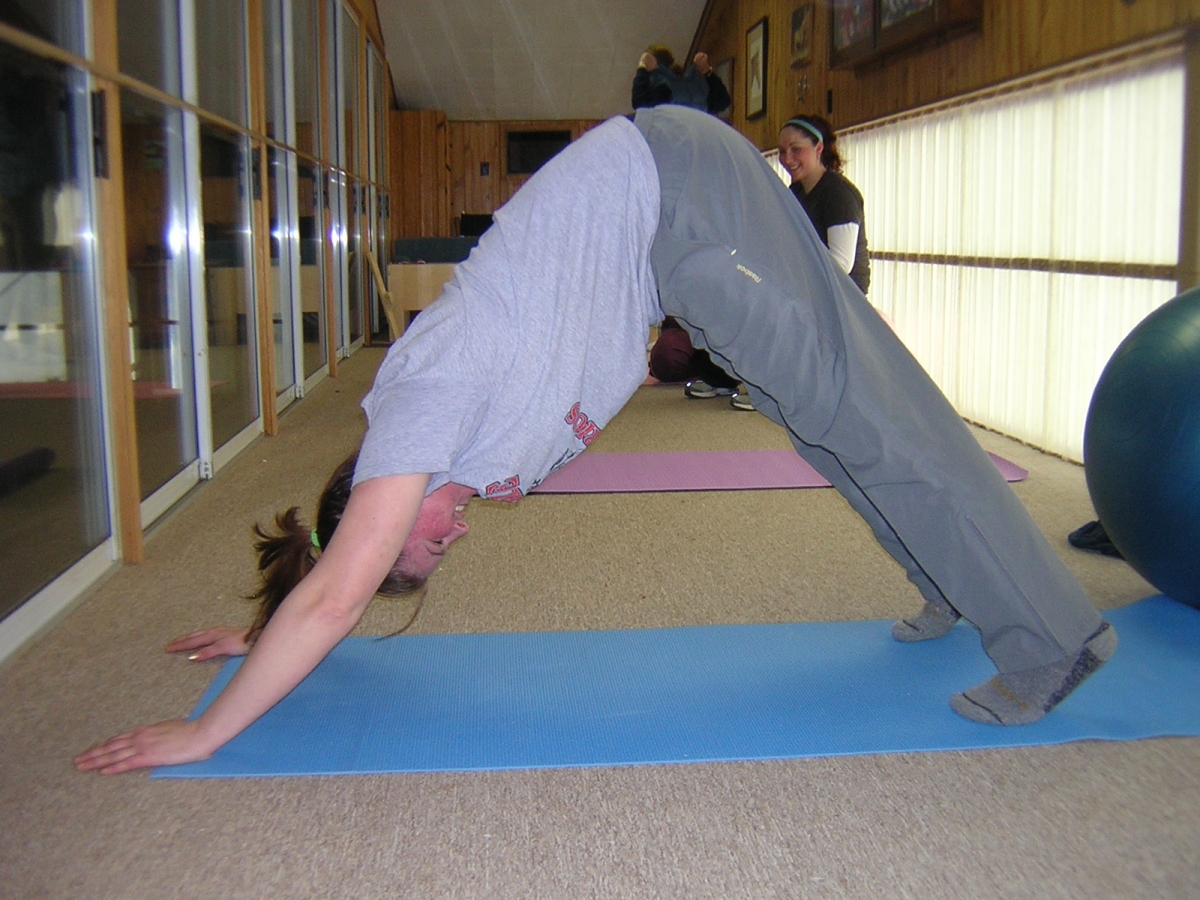
Photo #4: Downward Dog
Start on all fours, then lift your tailbone into the air while straightening your knees to create an ‘A’ with your body.
Keep your hands and feet about shoulder width apart.
As you breathe in and out, reach your tailbone back and up, and allow your chest to drop closer to the floor keeping a flat back (see photo #4).
In the simple pigeon pose, one leg is folded in front of you as if you are about to sit cross-legged on the floor.
The other leg is stretched out behind you in a straight line.
You can lean forward slightly and support your body weight on your hands to reduce strain on your joints. To add a stretch for your hip flexors, lift your shoulders up and backward. Reaching back to hold your foot will also stretch your quadriceps (see photo #5).
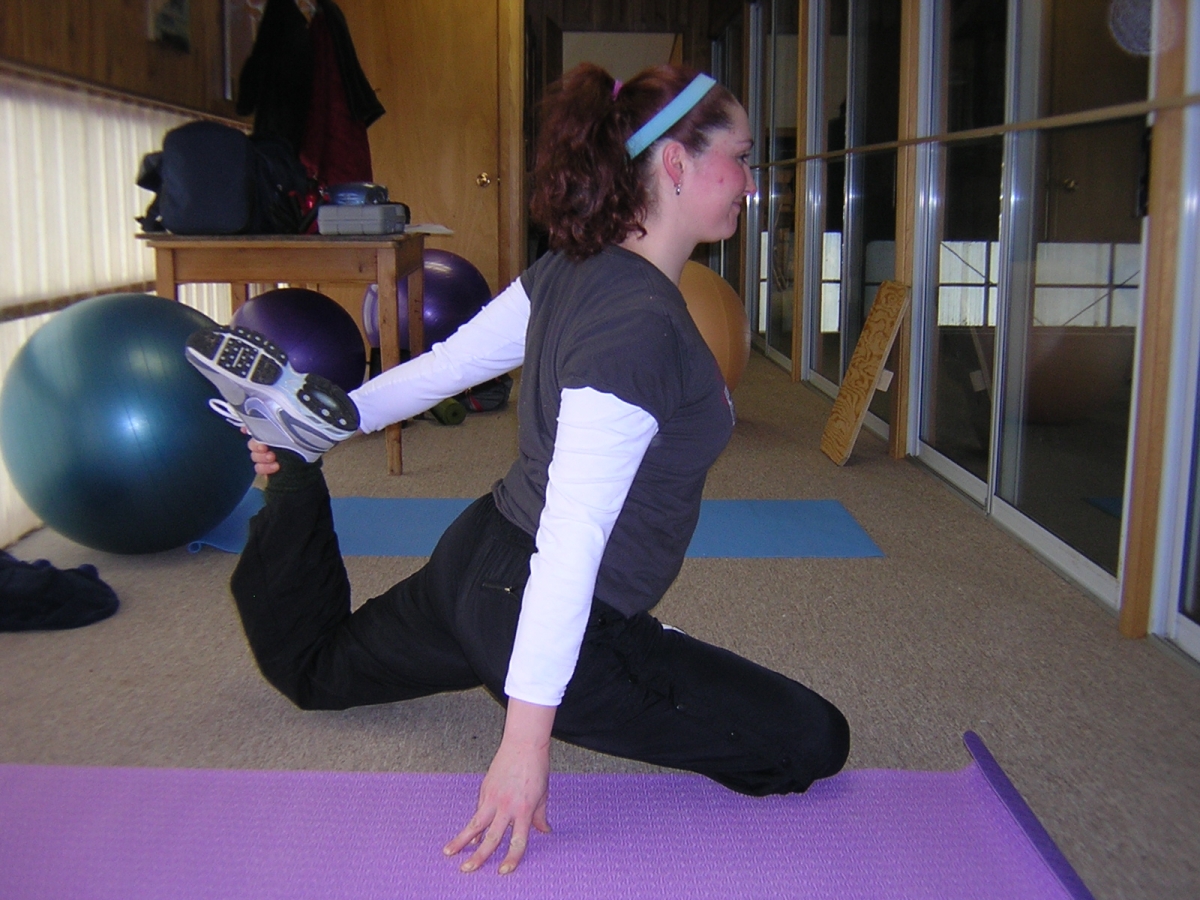
Photo #5: Pigeon Stretch with Leg Bent
Nutrition for Competition
Finally, I do get asked about nutrition for show day. Remember to drink water often. Staying hydrated will help keep you on top of your game mentally and physically each training day, and especially throughout a busy show day in the heat. If you drink coffee, you need to drink two glasses of water for each cup of coffee to compensate for the dehydrating effect of the coffee. If you can, don’t drink coffee on a show day, and go for the juice and water instead. Water with lemon or lime chunks in it will replace your electrolytes as effectively as a sports drink, without the added sugars, additives, and colour.
Eating light and often will keep your blood sugar up while avoiding lethargy from an overfull stomach. If you get competition jitters, frequent and small portions will help keep your stomach from getting too acidic from being empty too long, or queasy from too much/the wrong mix.
Starting your day with a high energy breakfast that is low in fat and high in fibre will give you fuel for several hours and a good start, without increasing stomach acidity or creating other digestive complaints. I use oatmeal because it’s easy on the stomach, very high in fibre and energy, and provides glucose available to muscles for hours.
To read more by Heather Sansom on this site, click here.



